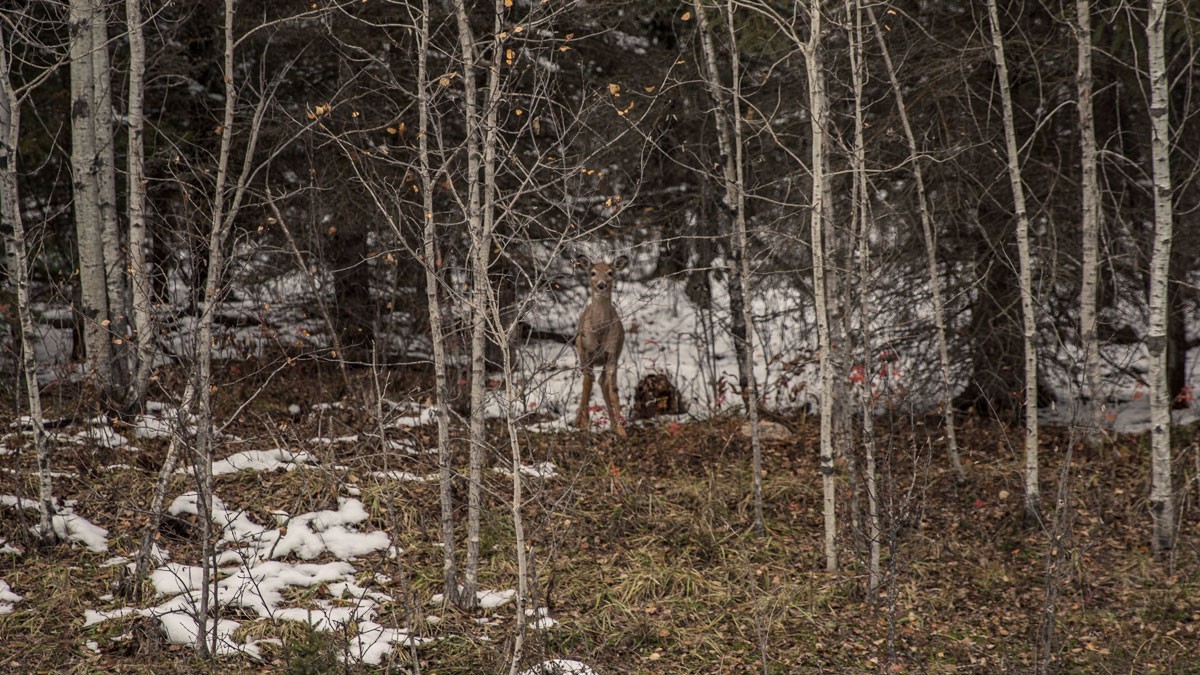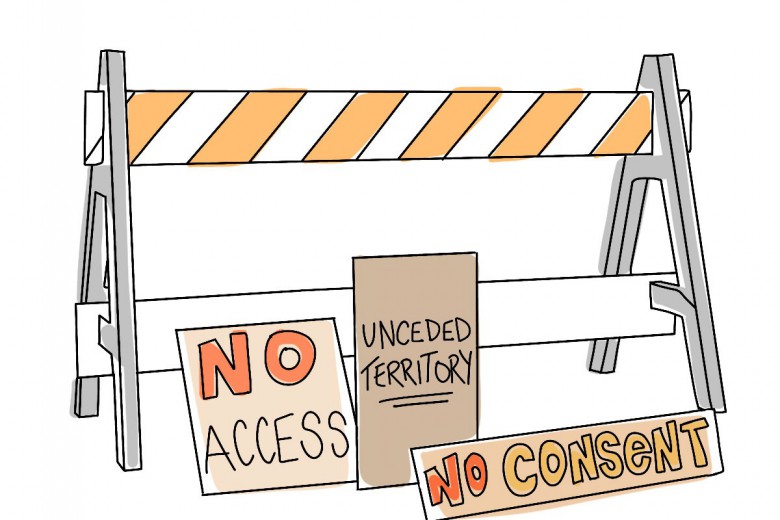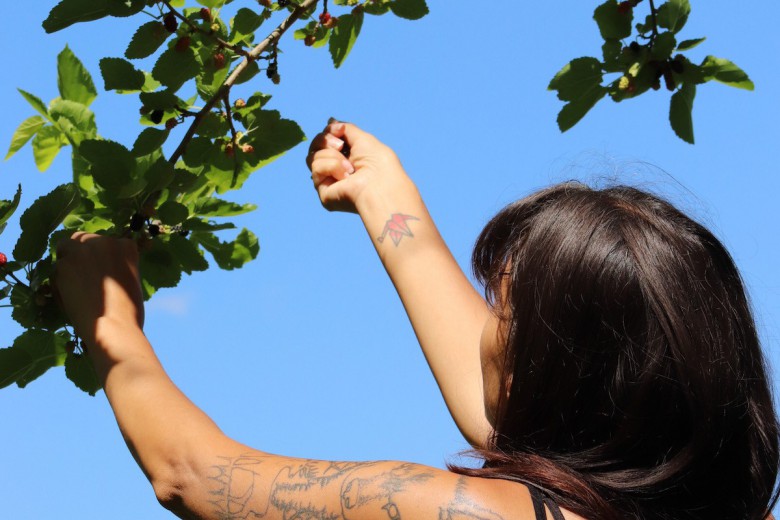A few hours north of Saskatoon, the trees become thicker and the air fresher, although the winding highways and grid roads remind me that modern-day transportation is undoubtedly an intrusion and I am only a guest here. Each visit I’ve made in the past year has revealed stark evidence that such robust beauty does not go untouched in the pursuit of profit.
I was once ignorant to the greed that fuels the destruction of these stolen forests, trees, and wildlife. But after a few days on the land, away from the city, I continue to learn from one of the territory’s traditional titleholders the hard reality of clearcutting and forest degradation.
Sylvia McAdam Saysewahum*, one of the founders of Idle No More, is welcoming each time I visit. With a warm voice and fierce values, Sylvia is a patient host who shows me first-hand the ways in which her home is under attack.
After spending a couple of days with Sylvia over the past year, it’s apparent that the roots of her resistance and the foundation for her work with Idle No More are heavily embedded in her family’s traditional Nêhiyaw hunting grounds, tucked away deep in the boreal forest on Treaty 6 territory. “It’s beautiful here,” she tells me. “There’s nowhere else I’d rather be.”
Sylvia’s earliest years were atypical for someone of her generation. She and her siblings avoided residential school, educated instead on their father’s hunting territory where land-based education mirrored that of a long line of traditional hunters who were all born, raised, and buried on the territory.

With a father from the Wind Clan and a mother from the Eagle Clan, Sylvia didn’t speak a word of English until kindergarten. Although her traditional history extends beyond the borders of a reserve, Sylvia’s family are members of what is now called the Big River First Nation, a reserve along the southern edge of the Prince Albert Forest Management Area. That land is home to trembling aspen, pine, spruce, balsam, fir, poplar, and birch, all now under threat of clearcutting.
Until nearly 18 years ago, Sylvia’s father’s hunting cabin was tucked away deep in the bush. Sylvia tells me it had been burnt down in the late 1990s, and her family’s wasn’t the only one. “My father’s hunting territory is two full days of walking in each direction,” she noted. Now, all that remains is an emptied-out space in the land where the cabin and surrounding forest once existed.
Cutting away at the land
Clearcutting is the commercial removal of healthy trees. Throughout our tours of the land, Sylvia directs attention to the growing number of emptied-out locations where flourishing forests were once her playground.
During my most recent visit, Sylvia shows me where she sleeps. After relocating a few times due to safety concerns and clearcutting exposure, she feels safer in her latest location. Next to a small body of water, her home is surrounded by the sounds of untouched nature, interrupted only when Sylvia builds a small fire with the wood that immediately surrounds the site.
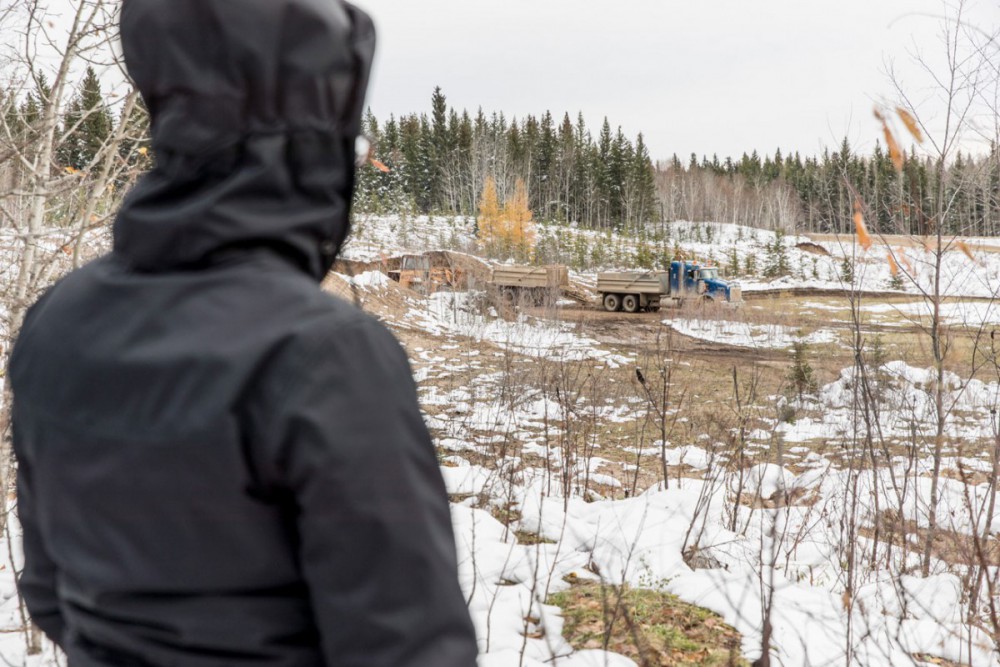
Sylvia believes that the Natural Resources Transfer Act, signed in 1930, was the start of the clearcutting. The act placed First Nations’ reserve land under the Crown, guaranteeing that natural resources, even on reserves, are “administered by the Government of Canada for the purposes of Canada.” It’s one of many “colonial apparatuses the government uses to assert jurisdiction over our lands,” says Sylvia.
Forest management
In 2010, the Saskatchewan government entered into a 20-year forest management agreement (FMA) with Sakâw Askiy Management Inc. (Sakâw). The FMA granted the company a licence to harvest the forest in the Prince Albert Forest Management Area, which encompasses 3.3 million hectares of boreal forest north of Prince Albert. Typically, in order to receive a commercial licence to harvest timber, a forestry company is required to develop a forest management plan that explains to the Ministry of Environment how the company has consulted with affected Indigenous people, and how it will ensure a “sustainable rate of harvest.” Companies that receive FMAs also usually commit to forest renewal obligations. If FMAs are approved, companies are granted operating plans.
Sakâw represents eight shareholder companies, including six companies with manufacturing facilities, and two First Nations businesses. Each shareholder has been granted harvest allocations, and Sakâw reports on their operations. A.C. Forestry, located near Big River First Nation, is the shareholder with allocations closest to Sylvia’s traditional hunting grounds.
“Sakâw Askiy began collecting operating plans from [the Ministry of] Environment to begin clearcutting,” Sylvia says. These plans, in the form of contracts, bypassed band members and were approved in May 2012 by the chiefs and councils of surrounding reserves Pelican Lake, Big River, and Witchekan Lake. According to Sylvia, the Big River chief and council rarely consult with their band members in approving operating plans. At a community meeting held with band members, chief and council, and the Ministry of Environment, Sylvia learned that the chiefs from Pelican Lake, Big River, and Witchekan Lake – the same reserves that approved the Sakâw’s plans without consulting members – sit as directors of A.C. Forestry.
During the fall of 2015, on the heels of the federal election, Sylvia says the clearcutting process became “a frenzy” and “a total land-grab.” The transition to a new government, she explained, created uncertainty. “The atmosphere becomes unclear and unstable [during the transition]. Extractive industries move quickly to get as much as they can before changes are made,” she says.
Sylvia doesn’t oppose logging altogether; what she objects to is the lack of consultation of the traditional landowners, the excessive extraction, and the waste of otherwise healthy trees.
What’s the cost?
Sylvia’s defence of the land hasn’t always been without risk. At times, Sylvia is on the territory alone. During the late summer of 2016, she noticed shotgun holes through a sign she had put up that read, “No Clearcutting.”
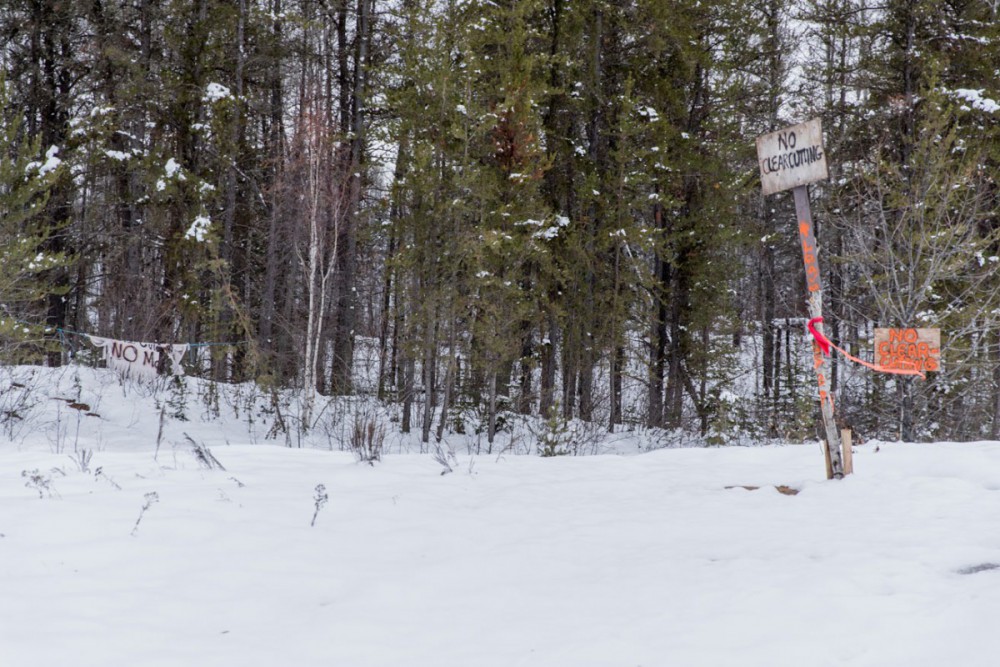
“My grandson has stopped coming to the lands with me. He doesn’t feel safe anymore,” she says. Shortly after he stopped joining her, her tent went missing. Then she found out that employees of the nearby logging companies follow her on social media, where she posts often about her struggle against the clearcutting. While these posts allow her to draw broad attention to the issue, they also reveal when she is home or away.
Sylvia now carries a gun with her for protection. “If farmers can carry guns to defend their lands, why can’t Indigenous women?”
Deep impacts
The forestry industry is northern Saskatchewan’s second largest industry, generating over $1 billion in forest product sales and $800 million in exports. Sylvia is all too aware of the effects of this industry on people and wildlife.
“These companies clear cut [and profit from the wood that’s used] to build homes, while my people are still homeless.” Sylvia herself sleeps in her trailer, but even now, she is without a home in the city or on her reserve.
In an environment of wind chills that reach as low as -50˚C, the boreal forest protects vegetation and wildlife. Clearcutting forces wildlife to travel farther to find food. When trees are clear cut, the carbon that is usually stored in trees, soil, peat, and moss is released into the atmosphere.
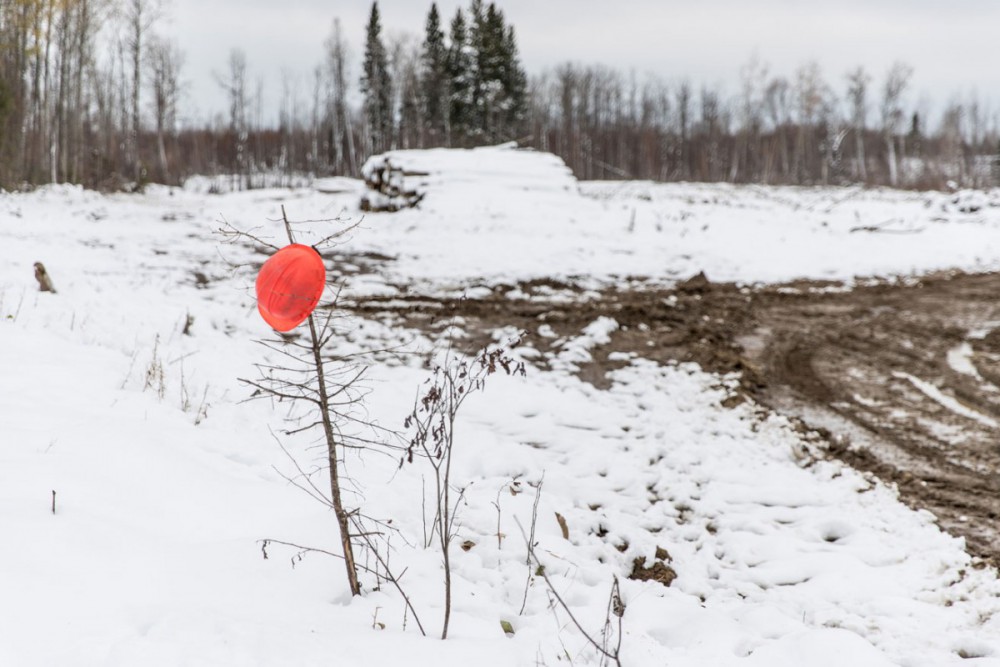
“[The clearcutting has] changed the water,” Sylvia explains. “[And] when I wake up in the morning, I don’t hear the birds anymore. Where are we going to get our feathers for ceremony? Where are we going to get our food for ceremony? Even the medicine has been displaced.” The deer in the surrounding area, she has noticed, have become “sickly and thin.”
Boreal clearcutting
In many ways, Sylvia isn’t alone in her struggle because boreal clearcutting isn’t limited to Saskatchewan.
Métis artist Christi Belcourt, who lives in northern Ontario’s Espanola, says, “[A] majority of people reside in southern Ontario and are not aware that clearcutting is happening all over Ontario.”
Christi sees its harsh effects in nearby decimated ecosystems. “The forestry companies are not replanting and if they are, it’s only one species.” Depending on the area, forestry companies commonly replace degraded forestation with single-species trees. “Global warming, climate change, and increasing human population means that strong, diverse forests are needed more than ever,” she explains.
Christi hears the logging trucks arrive early in the morning and exit with full loads by noon.
“We need to stop the devastation that is happening to the lands and waters, and invest heavily into alternative building methods, products, science, and technology that will make this country a global leader for land stewardship around the world.”
In Asubpeeschoseewagong (Grassy Narrows, Ontario, Treaty 3), community members have been fighting for an environmental impact assessment (EIA) of the logging of the Whiskey Jack boreal forest. Internal government emails obtained by a freedom of information request from the Toronto Star reveal that government scientists have acknowledged that logging releases mercury into rivers and lakes. Nonetheless, the province’s environment ministry has denied Grassy Narrows the EIA. The clearcutting continues with a 10-year FMA.
In B.C., meanwhile, where the forestry industry annually brings in $12 billion, Indigenous people are leading the resistance to the clearcutting and flooding of Treaty 8 boreal forest in preparation for the Site C hydroelectric project, emboldened by a history of anti-logging actions like the Haida Nation’s creation of the Duu Guusd Tribal Park in Haida Gwaii and the Tla-o-qui-aht Nation’s establishment of a park on Meares Island, in both cases to protect the regions from logging.
Land and bodies
This treatment of the land is directly linked to the colonization of Indigenous people, as clearcutting becomes an aggressive means to eliminate traditional lifestyle. Indigenous people are not separate entities from the land; they exist because of the land. Leanne Betasamosake Simpson has acknowledged the Indigenous nations “who are so in love with their land, they are the land.” Erica Violet Lee likewise makes this point when she writes: “And what of the theft of Indigenous languages and the destruction of waterways and forests? When we love on this land it is never separate from these things.”
Burning down cabins, shooting at Sylvia’s signs of resistance, and stealing her tent are all symptoms of a colonial construct fuelled by land-based profit. Christi foresees that forest degradation will have intergenerational effects, just as residential schools have. “We are headed for great suffering for the coming generations if we lack the foresight to do the right thing now for them,” she says.
“I’ve come to realize that my life has no value to the process of colonization,” Sylvia says. “As land protectors, our lives are primarily unprotected and not valued. I feel like my life is easily disposable as a protector and as an Indigenous woman.”
Although clearcutting shows no signs of slowing down, Sakâw Askiy will have to dig a lot deeper to separate Sylvia from her tireless and invaluable defence of the land of her traditional roots. “We are, after all, the titleholders of these lands. That needs to be respected and honoured,” she says.
*In keeping with the author’s request, we refer to Saysewahum by her first name throughout.


